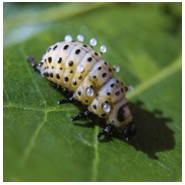| Wilhelm Boland
Max-Planck-Institut für Chemische Ökologie
 Leaf beetles occur worldwide; some of them are even economically important pests of agri¬culture.They raise broad ecological interest because of their host plant preferences and varying modes of life. Their larvae have developed an impressive repertoire of toxins and repellents to defend themselves against predators. Upon attack, the larvae discharge small droplets from specialized glandular reservoirs on their back (e.g. Chrysomelapopuli). The reservoirs represent “bioreactors” performing all late reactions of the toxin-produc¬tion, starting from plant-derived or de novo synthesized glucosides of non-toxic, early precursors of the compounds in the defensive droplets. The import of the plant-derived glucosides relies on a sophisticated trans¬port system. Physio¬logical studies revealed a functional network of transporters guiding the plant derived glucosides through the larval body into the defensive system. Excess of the compounds is excreted via other transporters in the Malpighian tubules. The first of the involved transporters has been identified and characterized concerning selectivity, tissue distribution, and regulation. The development of a well-tuned transport system, per¬fectly ad¬jus¬ted to the compounds pro¬vided by the food plants, provides the func¬tional basis for the leaf beetle defenses and their local adaptation to their host plants. Adaptation is demon¬strated by a defective oxidase that developed after a host plant shift of Chrysomela lapponica from salix to birch. Leaf beetles occur worldwide; some of them are even economically important pests of agri¬culture.They raise broad ecological interest because of their host plant preferences and varying modes of life. Their larvae have developed an impressive repertoire of toxins and repellents to defend themselves against predators. Upon attack, the larvae discharge small droplets from specialized glandular reservoirs on their back (e.g. Chrysomelapopuli). The reservoirs represent “bioreactors” performing all late reactions of the toxin-produc¬tion, starting from plant-derived or de novo synthesized glucosides of non-toxic, early precursors of the compounds in the defensive droplets. The import of the plant-derived glucosides relies on a sophisticated trans¬port system. Physio¬logical studies revealed a functional network of transporters guiding the plant derived glucosides through the larval body into the defensive system. Excess of the compounds is excreted via other transporters in the Malpighian tubules. The first of the involved transporters has been identified and characterized concerning selectivity, tissue distribution, and regulation. The development of a well-tuned transport system, per¬fectly ad¬jus¬ted to the compounds pro¬vided by the food plants, provides the func¬tional basis for the leaf beetle defenses and their local adaptation to their host plants. Adaptation is demon¬strated by a defective oxidase that developed after a host plant shift of Chrysomela lapponica from salix to birch.
M. Kunert et al., De novo biosynthesis versus sequestration: a network of transport systems supports in ancestral leaf beetle larvae both modes for the production of iridoid defenses.(2008)Insect Biochem.& Mol. Biol., 38, 895–904.
S. Discher et al., Chrysomelina larvae possess a transport network for sequestering and excreting plant glucosides as a source for chemical defense. (2009), ChemBioChem, 10, 2223–2229.
R. Kirsch et al., Host plant shifts affect a major defense enzyme inChrysomelalapponica. (2011) Proc. Natl. Acad. Sci., USA 108, 4897-4901.
R. Bodemann et al., Precise RNAi-mediated silencing of metabolically active proteins in the defense secretions of juvenile leaf beetles RNAi in leaf beetles. (2012) Proc. Royal Soc. Ser. B., 279, 4126–4134.
|
 Leaf beetles occur worldwide; some of them are even economically important pests of agri¬culture.They raise broad ecological interest because of their host plant preferences and varying modes of life. Their larvae have developed an impressive repertoire of toxins and repellents to defend themselves against predators. Upon attack, the larvae discharge small droplets from specialized glandular reservoirs on their back (e.g. Chrysomelapopuli). The reservoirs represent “bioreactors” performing all late reactions of the toxin-produc¬tion, starting from plant-derived or de novo synthesized glucosides of non-toxic, early precursors of the compounds in the defensive droplets. The import of the plant-derived glucosides relies on a sophisticated trans¬port system. Physio¬logical studies revealed a functional network of transporters guiding the plant derived glucosides through the larval body into the defensive system. Excess of the compounds is excreted via other transporters in the Malpighian tubules. The first of the involved transporters has been identified and characterized concerning selectivity, tissue distribution, and regulation. The development of a well-tuned transport system, per¬fectly ad¬jus¬ted to the compounds pro¬vided by the food plants, provides the func¬tional basis for the leaf beetle defenses and their local adaptation to their host plants. Adaptation is demon¬strated by a defective oxidase that developed after a host plant shift of Chrysomela lapponica from salix to birch.
Leaf beetles occur worldwide; some of them are even economically important pests of agri¬culture.They raise broad ecological interest because of their host plant preferences and varying modes of life. Their larvae have developed an impressive repertoire of toxins and repellents to defend themselves against predators. Upon attack, the larvae discharge small droplets from specialized glandular reservoirs on their back (e.g. Chrysomelapopuli). The reservoirs represent “bioreactors” performing all late reactions of the toxin-produc¬tion, starting from plant-derived or de novo synthesized glucosides of non-toxic, early precursors of the compounds in the defensive droplets. The import of the plant-derived glucosides relies on a sophisticated trans¬port system. Physio¬logical studies revealed a functional network of transporters guiding the plant derived glucosides through the larval body into the defensive system. Excess of the compounds is excreted via other transporters in the Malpighian tubules. The first of the involved transporters has been identified and characterized concerning selectivity, tissue distribution, and regulation. The development of a well-tuned transport system, per¬fectly ad¬jus¬ted to the compounds pro¬vided by the food plants, provides the func¬tional basis for the leaf beetle defenses and their local adaptation to their host plants. Adaptation is demon¬strated by a defective oxidase that developed after a host plant shift of Chrysomela lapponica from salix to birch.